The gear ratio is a value that characterizes the ratio of the number of teeth of the driven gear to the driving gear. It is the main indicator of the efficiency of any gear train.
A manual transmission is a multi-stage gearbox designed to increase or decrease the torque transmitted from the engine flywheel by cardan shaft, and subsequently - on the driving wheels. The control of such a gearbox is carried out manually using a special lever installed in the passenger compartment. Upon reaching maximum speed one gear, the driver sets the lever to a position in which the second gear is activated, thus the revs decrease and the torque changes.
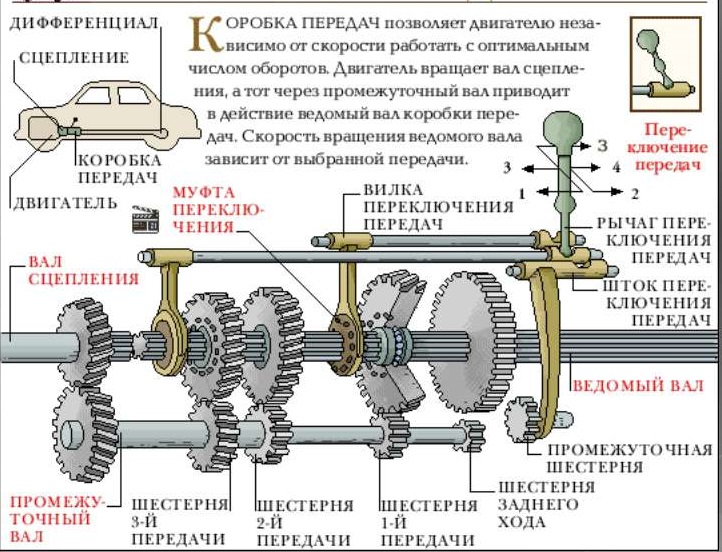
Any manual transmission is a collection of certain shafts and gears. The drive shaft is connected to the engine flywheel via a clutch and takes over the main torque. The moment is transmitted to intermediate shaft, and from the last - to the slave, which connects to cardan shaft and transmits the modified torque to the drive wheels of the vehicle.
All the gears of the car are combinations of the position of the gears and they differ from each other in the gear ratio.
How to determine the gear ratio (RR)?
As you already understood, the gear ratio is the ratio of the number of teeth of the driven gear to the number of teeth of the drive gear. Thus, calculating the gear ratio is not difficult. Let's look at an example. Suppose there is a pair of gears with the following gear ratios: 40 and 20. In order to make a calculation, you need to know which of them is the leading and which is the driven, and we will designate them by the letters A and B, respectively.

Suppose A \u003d 40 and B \u003d 20. It turns out that the number of teeth of the leading one is 40, and the number of teeth of the driven one is 20. Accordingly, to find out the gear ratio of a given gear, it is necessary to divide 20 by 40 and get 0.5. This means that the gear ratio of this gear is 0.5. If the gears are reversed, the number of teeth of the driving gear will be 20, and the driven gear will be 40. Then, dividing 40 by 20, we get the number 2. In this case, the gear ratio of this gear will be 2.
This calculation method is used in the design of the vehicle transmission. So that the car has excellent dynamic characteristics and develops great speed, it is necessary to choose the correct gear ratio of the gearbox.
To find out the transmission ratio of your car, just look in the technical literature for your car model. In other cases, the determination of the gear ratio can be carried out without the use of special calculations and literature. It is enough to know the principle of performing one method of calculating the gear ratio.
Place the car on inspection pit, be sure to place wheel chocks under the wheels. The gearbox must be in neutral. Take the chalk and mark the special marks on the wheel and the floor so that they match. Put the same marks on the housing and the flange of the gearbox. rear axle.
Ask the assistant from the pit to observe the coincidence of the marks on the gearbox and the flange, and you rotate drive wheel... After the repeated coincidence of the marks, the number of revolutions (it may even be equal to 1) of the wheel is calculated, divided in half and then, the resulting numerical value is divided by the number of revolutions made by the propeller shaft. The end result will be the gear ratio.
How the gear ratio affects the dynamic performance of the car
As previously mentioned, a properly calculated gear ratio will maximize transmission efficiency and reduce gear wear to a minimum. The choice of gear ratio is influenced by the characteristics of the engine, its power, torque, wheel diameter, the purpose of the car and the personal wishes of the motorist. Changes to the gear ratio can increase or decrease the torque transmitted to the vehicle's propeller shaft. The process of changing the gear ratio of a gear is to change the number of gear teeth.
If the gear ratio is high, the car will pick up high speed in a short period of time, however, the gear length will be much shorter. This means that gear changes will need to be done quickly enough. Simply put, increasing the gear ratio increases the acceleration rate of the vehicle.
Reducing the gear ratio allows you to achieve a large maximum speeddeveloped by the car. A different principle applies here, when acceleration is slow, however, the output speed will be much higher. This gear ratio is only suitable for sufficiently powerful motors.
Based on the above, the gear ratio should be such that the car has good dynamic characteristics and a high top speed. In this case, by selection, it is possible to achieve a compromise between the two values, having obtained both.
Many racers try to make gear ratios with a consistent reduction. That is, in the process of increasing the speed of the car and changing gears, the gear ratio of each next gear will decrease, which will allow achieving both increased dynamic characteristics and a high maximum speed.
High speed is relevant only when driving in a straight line, with a minimum number of turns. When driving on a winding road, it is recommended to use higher gear ratios. This is how the inverter is matched to the type of route.
What is gear ratio?
Quite often from car owners you can hear the question "what is the gear ratio". In this article I will try to briefly cover this topic. So, transmission mechanisms transfer the rotation of one shaft to another, i.e. make the second shaft rotate through the rotation of the first. This question was investigated by Leonardo da Vinci. Some of his inventions are used to this day in the construction of bicycles and even cars. So, on the basis of his sketches of gears, globoid worm gear, bevel, spiral gears and roller chains, the currently operating gearbox mechanisms of the car were developed. The gear ratio is the ratio of the angular velocities of the leading to the driven gear (wheels, shafts) or the ratio of the radii of the driven to the driving gear. In particular, gear ratios of the gearbox are determined by the ratio of the number of teeth of the driven gear to the driving gear. In the case of several pairs of gears participating in the transmission, the total gear ratio is the product of the gear ratios of all pairs of gears participating in the transmission.
How does the transmission work?
In order to obtain a torque of different magnitudes, which will allow the car to work in different conditions, several pairs of gears are installed in the gearbox, which have different gear ratios. "Reverse" gear is obtained by placing another intermediate gear between the driving and driven gears, which will reverse the rotation. 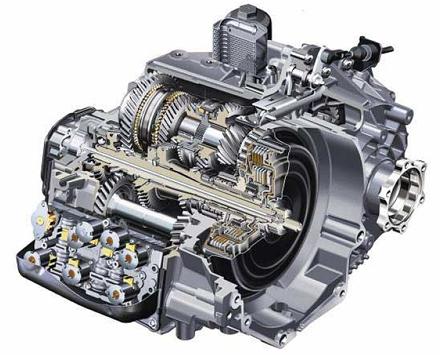 Any gearbox, manual, automatic or robotic, provides optimal engine operation in different road conditions by changing the gear ratio. Also in any gearbox there are high and low gears. The larger the gear ratio, the more powerful (or shorter) the gear is considered. This means that the more powerful the gear, the faster the engine revs. In this case, however, the gear change frequency also increases. This is due to the fact that in a given gear, the maximum speed at which the gear must be shifted higher will be lower.
Any gearbox, manual, automatic or robotic, provides optimal engine operation in different road conditions by changing the gear ratio. Also in any gearbox there are high and low gears. The larger the gear ratio, the more powerful (or shorter) the gear is considered. This means that the more powerful the gear, the faster the engine revs. In this case, however, the gear change frequency also increases. This is due to the fact that in a given gear, the maximum speed at which the gear must be shifted higher will be lower.
Sports lovers
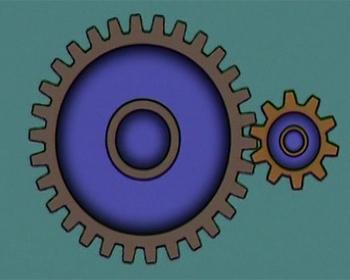 Some car owners want to improve the acceleration dynamics of their car. To do this, there is a way to change (i.e. increase) the gear ratio of the drive gear pair. Take VAZ 2108 as an example. Its gear ratio at the main gear is 3.7 - 3.9. If we increase this number to 4.3, then the effect, according to car owners, is simply amazing. With an engine volume of only 1.3 liters with such a gear ratio of the main pair, the car acquires the dynamics of a cannonball. The driver often had to change gears, but when moving from a place, for example, at a traffic light, the car is "in the lead." Maybe a Porsche 911 or JaguarXKR just wasn't around? Speaking of sports cars. On sports cars everything is much more serious. There the gear ratio can be increased to 4.7.
Some car owners want to improve the acceleration dynamics of their car. To do this, there is a way to change (i.e. increase) the gear ratio of the drive gear pair. Take VAZ 2108 as an example. Its gear ratio at the main gear is 3.7 - 3.9. If we increase this number to 4.3, then the effect, according to car owners, is simply amazing. With an engine volume of only 1.3 liters with such a gear ratio of the main pair, the car acquires the dynamics of a cannonball. The driver often had to change gears, but when moving from a place, for example, at a traffic light, the car is "in the lead." Maybe a Porsche 911 or JaguarXKR just wasn't around? Speaking of sports cars. On sports cars everything is much more serious. There the gear ratio can be increased to 4.7.
Commercial Gear Rows
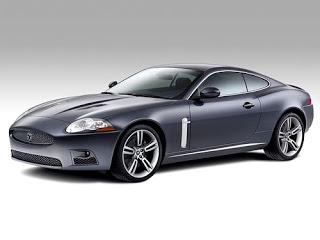 There are special commercial series for professionals. They are designed to provide even acceleration in all gears. So, for example, the first gear in such a row is slightly lowered, it becomes longer. The second is close to the first, which excludes the usual "failure" between gear changes. Third and fifth are similar to standard, fourth is close to third, and sixth gear is similar to fifth. With the help of such a series, you can improve the acceleration dynamics of the car.
There are special commercial series for professionals. They are designed to provide even acceleration in all gears. So, for example, the first gear in such a row is slightly lowered, it becomes longer. The second is close to the first, which excludes the usual "failure" between gear changes. Third and fifth are similar to standard, fourth is close to third, and sixth gear is similar to fifth. With the help of such a series, you can improve the acceleration dynamics of the car.
Almost any gearbox in modern cars consists of a set of gears that are used to ensure the desired engine operation and to transmit the required torque to the wheels through the gearbox. The exception is cVT variatorwhich uses stepless technology in its shifting. All other widespread boxes use gears that are of different sizes and can provide the necessary features of the machine. One of the main characteristics of the gearbox is the so-called gear ratio.
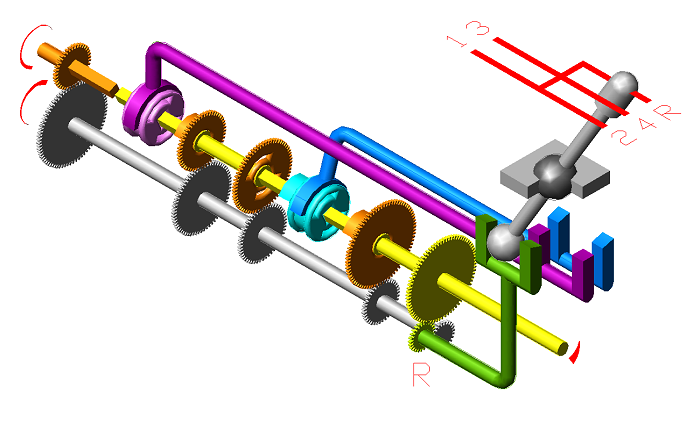
If the car did not have a gearbox, moving it would be difficult. And after the car had started, it would have been impossible to pick up a normal speed, because the engine spins up very quickly and reaches its peak. Therefore, an additional block with gears was invented, which turn on depending on the speed and operating mode of the car. Today we will talk about a moment like this technical characteristics machines like gear ratios.
The nature of the gear ratio and the scope of influence of this characteristic of the gearbox
Each manufacturer has their own considerations on how to determine the optimal number for a box. The nature of this value is quite simple - the ratio of the number of teeth of the drive and driven gear is calculated. If the drive gear has 60 teeth and the driven gear has 30, then the gear ratio will be 2 (60:30). If, on the contrary, the driving gear has 30 teeth, and the driven gear has 60, then the gear ratio will be 0.5 (30:60).
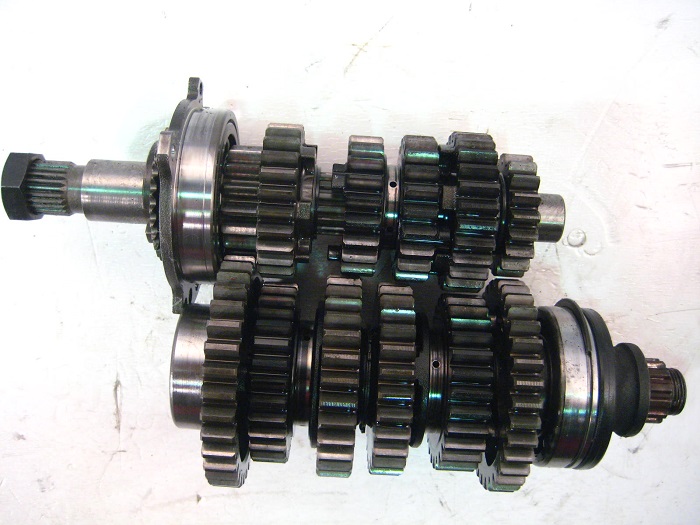
The sphere of influence of this factor is quite serious. If the gear ratio is not matched very well at the factory, the car will be extremely difficult to operate. Therefore, the concerns are trying to fine-tune the quality work of the checkpoint in this aspect as accurately as possible. In today's environment, the most common gear ratio ranges for standard and popular 5-speed manual transmissions are as follows:
- the first gear often has a number between 3 and 4;
- the second gear has a gear ratio of 2 to 2.9;
- third gear from 1.2 to 1.9;
- fourth gear from 0.9 to 1.2;
- fifth gear from 0.7 to 0.9;
- broadcast reverse from 3 to 4.
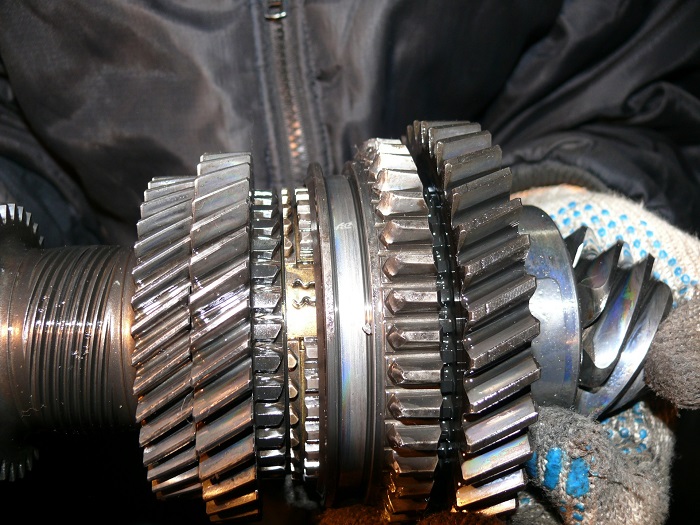
For automatic transmissions, longer ranges are often used in order to obtain smooth and flexible operation of the unit in various modes. With the help of the gear ratio, the length of the gears is determined, which seriously affects the quality and comfort of the driver's journey while driving. If the gear ratios are not set correctly, drive the car with mechanical box it will be terribly uncomfortable. And on a machine with a bad setting, constant jerks will appear, fuel consumption will be significantly overestimated.
These are the features that determine the gear ratio of the gearbox. The main task of properly configuring this mechanism is to ensure normal work engine in various modes. It is after determining the gear ratios and other features of the box that the manufacturer creates recommendations for speed modes and rpm for gear shifting. And also in connection with this information and its features, other mechanisms of the car are configured.
What should be the optimal gear ratio in the box?
It is impossible to talk about optimal performance in this case. The gear ratio of the gearbox is selected at the factory during the manufacture of the car, it is an integral characteristic of a particular gearbox. Therefore, it is impossible to talk about any digital values \u200b\u200bin this connection. This is the same as talking about excellence winter tires over the summer. They are simply different, because they are exploited in different seasons. With the gear ratio, everything is somewhat different, because its features affect the habits of the car.
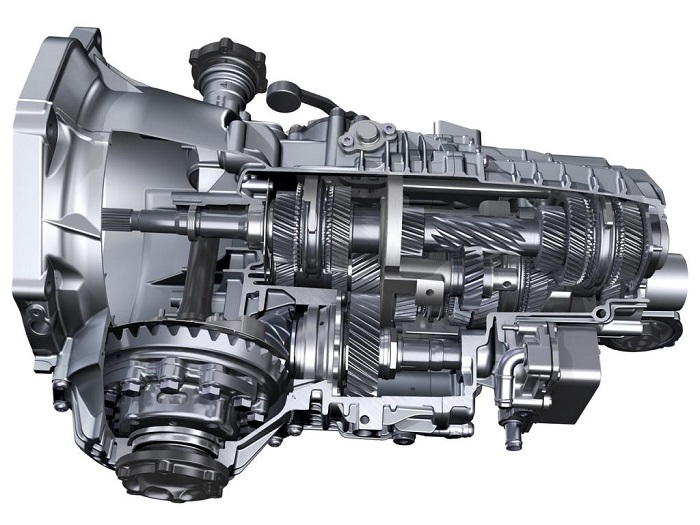
But for every driver, the ideal habits of the car are also different, so it is difficult to determine the optimal gear ratio. The convenience of driving a car with a specific gear ratio also depends on the engine power, its ability to pull from the very bottom. Otherwise, the driver will have to constantly change gears, and automatic transmission will constantly use rapidly failing mechanisms. It is important to select the correct gearbox ratio to ensure the following important aspects:
- comfortable operation of the car without excessive amount of gear shifting on the mechanics or automatic;
- the normal dynamics of the car, which is determined precisely by the settings of each individual gear;
- excellent work in a complex of all gears, no breakdown of one of the travel modes;
- ensuring normal fuel consumption during normal vehicle operation and the absence of gas overload;
- the presence of a long last gear that can accelerate the car to maximum speed;
- ensuring elastic operating conditions of the power unit, as well as the gearbox module itself;
- full compatibility of the developed engine with the gear ratios of the transmission in the car.
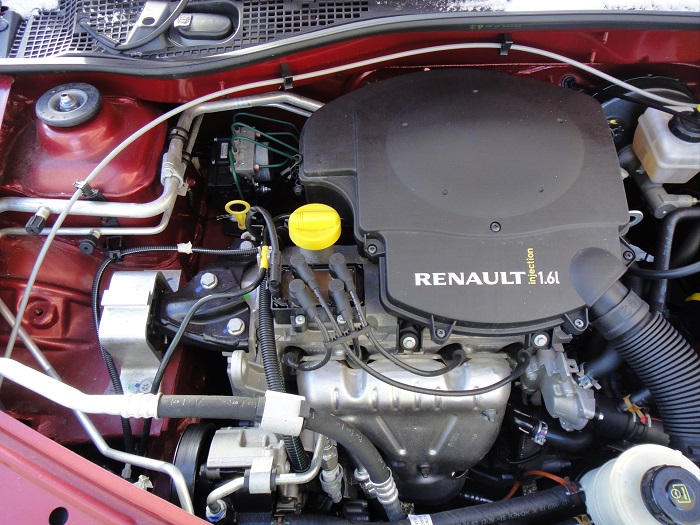
It is for these reasons that the manufacturer develops a box with specific gear ratios for each individual engine. Moreover, the installation of a non-native box on the car is fraught with serious consequences. If you decide to put on your car a gearbox from a more powerful modification of the same engine, then you will ensure serious violations in the operation of the car. We'll have to think about the high engine wear and not too comfortable gear shifting options.
By installing a gearbox on the engine from a less powerful power unit, you will steal part of the machine's potential. The box will not reveal the full potential of the unit, and will also force you to spend more fuel on the trip. These are the main reasons that make car manufacturers to make constantly new boxes with more versatile and better operating settings. Gear ratios are also highly dependent on the purpose of the machine.
If you want more information and technical points about the transmission, its characteristics and design, watch the following video:
Summing up
A very important aspect of transmission ratios is one of the most important characteristics of this part of your car. It is extremely important that your car has its own gearbox, because the engine will not be able to fully operate for a long time under the control of another transmission with changed gear ratios. Often the installation of new gears becomes the object of car tuning. Consider if you want to halve your engine life with a couple of extra horsepower.
The issue of setting gear ratios today is one of the main problems of weak engineering companies. road transport... It is precisely because of the unsuccessful decisions in the design of the gearbox that it turned out that some cars completely cannot fulfill their tasks and realize the potential of powerful and good power units... If you have something to supplement the story about the gear ratios of the car's transmission, tell us your opinion in the comments to the entry.
Transform driving performance the car can be absolutely without interfering with the engine. So what could a car be faster? This is a transmission, a gearbox in other words ...
In fact, the transmission and gearbox are not the same thing, but close. The transmission, in the case of front-wheel drive VAZs, includes the gearbox itself and the drives (SHRUS). In addition to the dynamics of the vehicle, the transmission also affects the maintenance of the trajectory when cornering. On this, perhaps, we will finish with the theory, let's move on to practice, which is more interesting :)
Never neglect gearbox tuning! even if at this stage you do not understand why it is important and why it is not cheap!

Do not be discouraged and do not give up the gearbox tuning. In fact, everything is extremely simple, at least in terms of choice. There are so-called " sports rows Checkpoint ". This is a ready-made set of all the necessary gears with modified gear ratios.
What can be done with a standard gearbox?
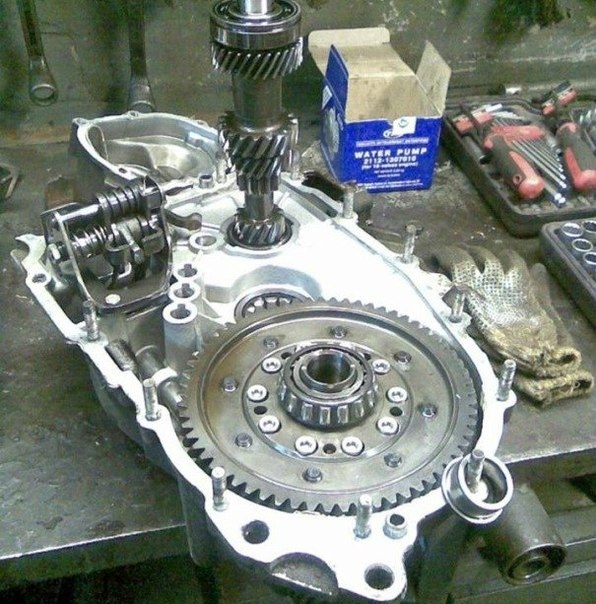
To begin with, the gear ratio of the main pair is changed to a higher one.
The gear ratio is the ratio of the number of teeth of the driven gear to the number of teeth of the drive gear. The higher it is, the transmission "Shorter" and "more powerful", that is, the motor very quickly twists the set number of revolutions, the speed gains are just as rapid, but there is a need for frequent gear changes. As a result, there is a slight decrease in the maximum speed in this gear.... With such a replacement, the car noticeably adds in dynamics. It is easier for the engine to pick up speed with a higher gear ratio of the main pair.
There is a downside - you have to switch gears more often, and the maximum speed of a car with a higher gear ratio of the main pair (GP) of the gearbox is significantly reduced. You can even roughly calculate how much the maximum speed decreases. Therefore, there is a certain distinction between tuning and pure sport in fine-tuning the car. That is, as already mentioned, you need to adhere to the "golden mean", to win in dynamics just enough so as not to suffer from a decrease in the maximum speed.
Next, you can change the gears to tuning gears. This is done in order to make overclocking as efficient as possible. Owners of "eights", "nines" and "ten" probably know that even if the engine is cranked strongly in first gear, when switching to second speed, the speed drops sharply, and the dynamics of the car also decreases. The reason for this is the too large gap between the gear ratios of the 1st and 2nd gears. Tuning ranks can be designed so as to ensure uniform acceleration of the car in all gears. For this, the gear ratios of some gears are changed compared to the standard ones, as a result, the engine, when accelerating, works in a fairly narrow and most convenient rev range.
For racing, a slightly different scheme applies: the first transmission is made as long as possible. In long first gear, the engine picks up easily high speed... The rest of the gears, on the contrary, converge, which makes it possible to optimally realize the engine power. At the same time, in order not to suffer from a lack of maximum speed, it is possible to install an additional 6th gear. Gear ratios are selected depending on the power and torque characteristics of the engine, wheel size and, most importantly, on the wishes of the car owner. After such a refinement of the gearbox, it needs the fastest and most accurate engagement of the selected gear. The design with traction gears, common for front-wheel drive VAZ vehicles, does not provide a clear "hit in gear", and it is significantly modernized by using more rigid cardan shafts and a short-stroke wings. This will allow the driver to move the lever faster. A clear shift in gears may be needed not only in competition conditions, but also in everyday city traffic (especially for drivers who prefer a hard, active driving style).
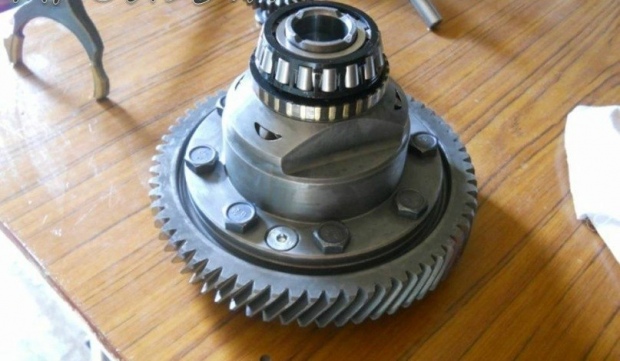
In addition to changing the gear ratios of the gears and GP - the installation of a limited slip differential... Usually the differential helps the wheels rotate with different angular velocitieswhich is useful when cornering where the inside wheel needs to spin slower than the outside, but sometimes it gets in the way. For example, when one wheel slips, the other does not move at all. Unlike a standard limited slip differential, part of the engine torque will still be transmitted to the wheel, which has better grip... When installing a limited slip differential, wheel slip at the start is reduced (the wheels rotate at the same angular speeds), the car enters corners more confidently. Of course, there are also small disadvantages - the car becomes more "nervous" and the driver needs to get used to the changed behavior of the car.
Blocker (blocking differential): improves the vehicle's cross-country ability both in winter on snowdrifts and in summer off-road, allows to reduce or remove slipping on a slippery road ...
Worm (screw) - increases the cross-country ability of the car on off-road, when one wheel slips, the second is automatically turned on (it is also on when cornering)
Disk (frictional) - provides constant rotation of 2 wheels, it is recommended to use it in serious competitions or only off-road.
Based on my personal experience and many of my friends! It's safe to say!
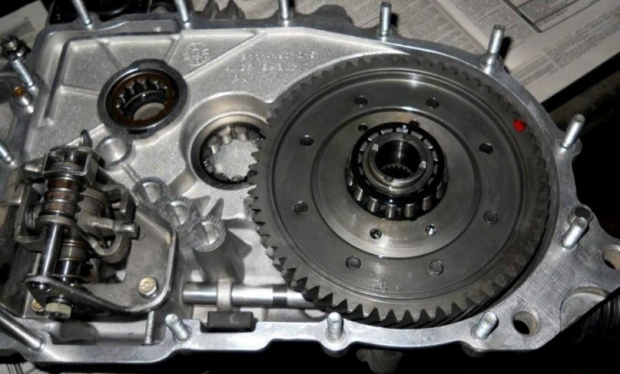
Optimal gearbox configuration for civil naturally aspirated engine:
18 row of gearboxes + main pair 3.9.
If you move more in the city than on the highway and don't drive at a breakneck speed on the highway, then you can choose a shorter pair 4.1 or 4.3
Optimal gearbox configuration for a sportier naturally aspirated engine: 7 row of gearboxes + main pair 4.3.
I also had the experience of riding on the 7th row with a pair of 4.1 and 4.5, there is no particular difference between a pair of 4.3 and 4.1, 4.5 of course borscht. For me, this is the most ideal row in the city. The most successful and without losing combination of 7 row and 4.3 pair, for almost any motor, both torque and power.
Optimal gearbox configuration for a turbo civil engine: 104 row + main pair 3.5.
Tuning a VAZ gearbox is a creative process.
Program with graphs, setting the checkpoint and GP.
› Types and gear ratios of the VAZ gearboxborrowed from the drive, the goal is one - information content, publicity.
What is the fundamental difference between classic gearboxes.
Gearbox 2101 (VAZ-2101, 2103, 21011, 21061): 1st - 3.753; 2nd - 2.303; 3rd - 1.493; 4th - straight line (1.000); 5th - no; RFP - 3.867.
Gearbox 2106 (VAZ-2106 and 2121): 1st - 3.242; 2nd - 1.989; 3rd - 1.289; 4th - straight; 5th - no; RFP - 3.340.
Gearbox 2105 with 5th gear (VAZ-2105, 2107 and 2104): 1st - 3.667; 2nd - 2.1; 3rd - 1.361; 4th - straight; 5th - 0.801; ZX - 3.53
At this time, instead of gearbox 2105, gearboxes 2107 (marking: 2107-1700010) and 21074 (21074-1700005) are being produced and installed. KPP 2107 is an analogue of KPP 2105, the gear ratios are exactly the same (which - see above); the fifth gear is added to the checkpoint 21074, so we have gear ratios: 1-4 and reverse gears - see checkpoint 2107 + 5th gear - 0.82
I also found a mention of the modification of the gearbox 2106, namely 2106-10 - the gear ratios exactly coincide with the gearbox 2105 (2107). There is little information, but probably this modification was renamed with the advent of the VAZ-2105 car and received the index 2105 (and later 2107 ) ... such is the story
KPP 2101, KPP 2106, KPP 2105 - REMOVED FROM PRODUCTION. Now they sell checkpoint 2107, checkpoint 21074 and you can still find checkpoint 2106.
Sports rows:
row 1R: 1st - 3.242; 2nd - 1.989; 3rd - 1.289; 4th - 1.000; 5th - 0.759.
row 2R: 1st - 3.007; 2nd - 1.989; 3rd - 1.289; 4th - 1.000; 5th - 0.759
row 3R: 1st - 2.424; 2nd - 1.768; 3rd - 1.240; 4th - 1.000; 5th - 0.585
row 4R: 1st - 2.424; 2nd - 1.675; 3rd - 1.186; 4th - 1.000; 5th - 0.585
*Ratio reverse gear I do not write, because for sports, it is not essential and is often simply not indicated ...
I omit sports, it's hard to find, and nafig is unnecessary.
Also (on the VAZ-2103/2106) the gearbox 2106-10 could be installed (a complete analogue of the gearbox 2105). Later, a unification was carried out at the factory assembly line and gearbox 2105 was installed on all classics. Now they put either gearbox 2107 (identical in gear ratios to gearbox 2106-10 and gearbox 2105), or 5-speed gearbox 21074.
There is one more problem in our cars ... the speedometer drive ...
Speedometer drives and the corresponding drive gears of the output shaft are used only in sets - other combinations are excluded:
a - drive 2101-1702150-01 without a label with 12 teeth of the driven gear and the drive gear 2101-1702158 with five worm starts, marked with one annular groove - for gearbox "Zhiguli" with rear axles 2101 (gear ratio of the gearbox - 4.3) and 2102 (gearbox 4.44). In the latter case, the speedometer slightly overestimates the readings;
b - drive 2103-1702150-01 (9 teeth), marked with red paint, and gear 2103-1702158 with four starts of the worm without a mark - for gearbox "Zhiguli" with a rear axle 2103 (gear ratio of the gearbox - 4.1);
c - drive 2106-1702150-01 (13 teeth), marked with blue paint, and drive gear 2106-1702158 with six worm starts, marked with two annular grooves - for “Zhiguli” with axle 2106 (gearbox - 3.9).
Now I'll tell you about Polonez (Polish checkpoint with all the consequences)
And now the most interesting thing, there are three types of gearboxes (all 5-speed ones) that were installed on Polonaises, the differences in gear ratios, so:
up to 87, they put a checkpoint with gear ratios I - 3.753; II - 2.132; III - 1.378; IV - 1,000; V - 0.881
87-93 years - put a checkpoint with gear ratios I - 3,778; II - 1.944; III - 1.307; IV - 1,000; V - 0.803
from 93 years old - put a checkpoint with gear ratios I - 3.830; II - 1.971; III - 1.321; IV - 1,000; V - 0.806.
The whole sadness of the situation is that it is difficult to get a new Pole, and the fact that there is a long time does not go, begins to flow like bitches. And what is most regrettable for them in the daytime with fire you will not find spare parts. Yes, and the Poles are still designed for engines with a volume of 1.7 to 2.0 (there were such on Polonaises). Therefore, they do not fit the classics very much and if they are placed (by cutting out a piece of the transmission tunnel), then they do not go long and the driving characteristics improve purely subjectively.
Now I'll go to my sample:
The checkpoint was purchased in September 2011 and installed on the car at the same time.
Gearbox model VAZ-21074-1700010-23.
Five-speed (see gear ratios above) + 5th gear
What does the index 23 mean at the end (in the photo it is applied with a blue marker on the case): They are deciphered as follows: "20" - a box for the main pair 4.1 + "03" - modification of the "insides" of the box.
The same with Niva: if the old box had an additional index "40", then the new one - "43".
A distinctive feature of the 23rd modification - the speedometer drive gearbox for a pair of 2103 (4.1) - is marked with red paint.
Gearbox interchangeability:
On the rear-wheel drive cars VAZ ("Zhiguli") of the first years of production, the same gearbox of the "2101" type was used. It was used for the VAZ-2101, "2102" models (until 1978 they were equipped with boxes without reverse light switches), as well as "21011", "21013", "2103". In 1976 the 2106 type gearbox with different gear ratios appeared. Since 1977, they began to install it on the VAZ-2121-"Niva" (this version does not have a speedometer drive, since the "Niva" has it located on transfer case). At the end of 1979, another version appeared - "2105" with its own range of gear ratios, intermediate between "2101" and "2106". This is necessary in order to meet more stringent requirements for efficiency, toxicity, noise level of new models - VAZ-2105, "2107", "2104" and modifications.
The choice of gear ratios allowed the 2105 gearbox to be used on all models with a classic layout, and since 1987 it has been used in all rear-wheel drive cars (Zhiguli). Only for "Niva" they still use a gearbox with gear ratios "2106".
Gearboxes also differ in speedometer drives, each of which corresponds, as shown in table. 2, a certain gear ratio main gear... Otherwise, the speedometer reading may deviate from the true speed. To avoid this error, if necessary, simultaneously with the box, replace the speedometer drive, referring to table. 2. On the clutch housing, opposite the breather, a marking is applied with paint indicating which car model the gearbox is intended for: the number "5" for VAZ-2105, "2104", "7" for VAZ-2107.
In recent years, some Zhiguli and Niva cars have been equipped with a five-speed gearbox. It is developed on the basis of a four-speed, interchangeable with it in place, and externally differs in the configuration of the rear cover, which houses a pair of fifth gear.
On four-wheel drive vehicles VAZ-2121 gearboxes can be used with two options of gear ratios: 4.3 and 4.1. The speedometer drives differ accordingly. When replacing or repairing gearboxes on these machines, it is imperative that the front and rear axles have the same gear ratio.
One more remark regarding all-wheel drive vehicles VAZ-2121. In order to improve the reliability and durability of the gearbox, the fixation of the axis of the satellites was changed in it, and nitrided spherical washers were installed under them. As a result, the interchangeability of housings and satellites axles has been lost. Therefore, if it is necessary to replace the housing in the gearbox released before 1986, you need to install the entire set of changed parts: housing 2121-1802163-200, axle 2121-1802160-10 and put washers 2121-1802161 under the satellites.
What to be guided by when replacing a transmission Remember that the 2105 type box is the most versatile for use. Five-speed box is definitely a winning replacement, especially for long-haul travelers, but not yet very affordable. In general, the parameters of the box were selected as a compromise between dynamic qualities, efficiency and reliability. Therefore, the VAZ-2106 with the 2101 gearbox will become more dynamic, but this will affect the durability of the rear axle parts. On the contrary, VAZ-2101, "21013" with a gearbox "2106" accelerates more sluggishly.
Similarly, a gearbox with a gear ratio greater than the stipulated one improves the dynamics, but "stimulates the appetite" of the machine, and at the same time the load on the half-axle gears and half-shafts will increase. Reverse replacement will manifest itself in some deterioration in dynamics, especially in direct transmission.
If, when replacing the gearbox, you find that the marking on it has been erased, the gear ratio can be determined without removing it from the machine. To do this, set the gear lever to neutral and hang out one of the rear wheels using a jack (the second should rest on the ground). Turn the raised wheel 20 turns and count the number of revolutions made by the propeller shaft. Dividing the resulting number by 10, you will find the final drive ratio.
Like 18 Share: Follow this User




